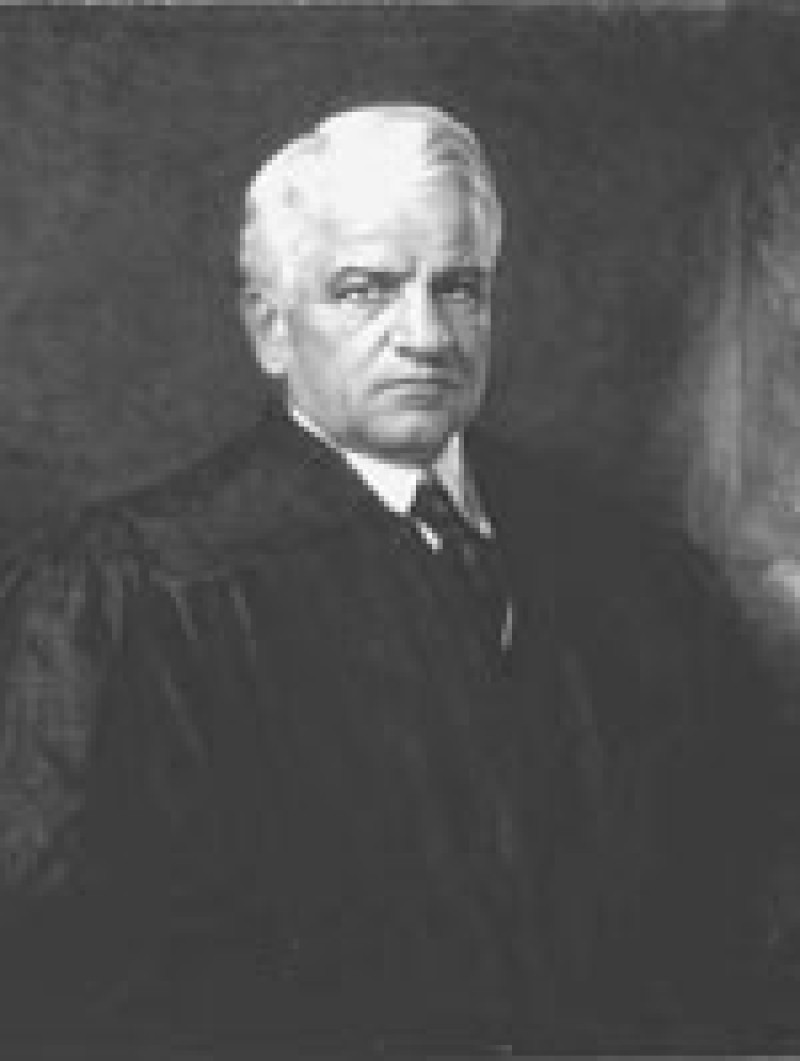John Hessin Clarke (Sept. 18, 1857 - March 22, 1945)
John Hessin Clarke gave voice to such progressive liberal causes as trust-busting, labor standards and world peace that were high on the agenda of early 20th century America. His campaigns for the Senate, tenure as a U.S. Supreme Court justice and years as an elder statesman for liberal policies exemplify his lifelong spirit and commitment to public causes.
Clarke was born in New Lisbon, Ohio. He grew up as a member of the local elite, with his father active in local Democratic politics. Following graduation from New Lisbon High School in 1873, John enrolled at Western Reserve College (now Case Western Reserver University). There he took a broad range of courses and, influenced by reading the work of Walter Bagehot, undertook the study of law. He graduated Phi Beta Kappa in 1877 and passed the Ohio bar examination cum laude in 1878.
After two years of practicing law in New Lisbon, Clarke moved to nearby Youngstown to become part-owner of a weekly Democratic newspaper, the Youngstown Vindicator. He continued to practice law while becoming active in local politics. In 1882 he sold his interest in the newspaper and interrupted his political activity in order to concentrate fully on the law. He turned to corporate law and honed his skill as a trial attorney. Clarke sought to raise the cultural level of the Youngstown community by giving public lectures on literature and leading the local public library movement. He soon moved to larger issues, speaking out statewide against the free coinage of silver, even though his own party supported it. He accepted a partnership at a prominent Cleveland law firm specializing in railroad and corporate law.
Clarke, 57, in 1914 took his place on the bench of the Federal District Court for the Northern District of Ohio. By 1916 Clarke had been on the bench two years and performed as Wilson had hoped. Following the retirement of Charles Evans Hughes, Clarke was rewarded with a nomination to the high court. Unlike Wilson's previous nominee, Louis Brandeis, Clarke's nomination sailed through the Senate without controversy, and he was unanimously confirmed on July 24, 1916.
Clarke's main contributions to the Supreme Court came in the areas of patent and antitrust law. In United States v. Reading Co. (1920) he wrote for a court majority declaring that Reading Railroad's ownership of a New Jersey railway, coal mining and carrying company was an illegal monopoly constituting ?a menace to and undue restraint upon interstate commerce.? This important precedent was used to enforce the Sherman Antitrust Act during the presidency of Franklin D. Roosevelt. In Abrams v. United States (1919) Clarke wrote the majority opinion upholding the conviction of six Russian-born aliens under the Espionage Act of 1918. Clarke, though a consistent supporter of civil liberties, including free speech, never regretted his opinion in Abrams, saying that wartime considerations had to take precedence. Perhaps Clarke's two most important dissents occurred in Hammer v. Dagenhart (1918) and Bailey v. Drexel Furniture Co. (1922), in which he supported the use of the Constitution's commerce clause and the taxing power by Congress to justify enacting legislation on child labor standards.
Justice Clarke felt that the Supreme Court was a tedious and restraining institution. He lamented the fact that he had to spend countless hours scrutinizing the minutiae of relatively unimportant cases and was unable to speak out on the issues of the day.
In his resignation letter Clarke had also mentioned that he wished to ?serve some public causes.? Much was made by the press of this aside, and when asked about it in a subsequent interview Clarke said that he would like to concentrate on facilitating America's entrance into the League of Nations. He continued to give speeches on world peace, and in 1937 he gave a nationwide radio address in support of President Franklin D. Roosevelt's attempt to expand the number of Supreme Court justices. He died at his home in San Diego, just as deliberations began on the formation of the United Nations.
Some content and graphic elements featured on webpages related to the Thomas J. Moyer Ohio Judicial Center were used with the permission of the Ohio Historical Society; the Prints and Photographs Division of the Library of Congress; the Office of the Curator of the Supreme Court of the United States and American National Biography Online.
Biography of John Hessin Clarke (Sept. 18, 1857 - March 22, 1945)
Citation: Artemus E. Ward. "Clarke, John Hessin"; http://www.anb.org/articles/11/11-00167.html; American National Biography Online Feb. 2000. Access Date: Fri Oct 3 10:06:17 2003. Copyright © 2000 American Council of Learned Societies. Published by Oxford University Press. All Rights Reserved.
Portrait of John H. Clarke - Office of the Curator, Supreme Court of the United States.

